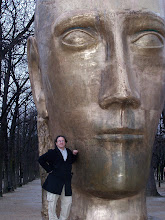The ICE is apparently an amalgamation of musicians (30) who come together in various configurations (chips), in this case four of them, an ICE Cube perhaps? In particular a flute (Claire Chase), a guitar (Daniel Lippel), a clarinet (Joshua Rubin), and percussion (David Schotzko) were the ICE on this occasion.
Edgar Guzman's Coincidences? was first. It included all four plus "tape". I suspect in this digital age, no tape was actually harmed in this performance, just digital bits. Whatever it came from, the recorded part was alienating, electric like a radio playing just static but with an edge. The players played around and through this, though two of them took time out to read the local alternative weekly, the City Paper. And I do mean read to themselves and looking a bit bored, then reading, I assume, random bits into the mikes. I wonder how this was written in the score. It was amusing and sometimes laugh out loud funny. It did remind me of confusion techniques that hypnotherapists use sometimes to put people in a trance.
Pilippe Manoury's Last used just the bass clarinet and marimba. This was arguably the most accessible piece on the program. My daughter, Julia, might even acknowledge that it is music. A good marimba player is always fun just due to the visuals of seeing all those mallets in too few hands seemingly hitting what they want to hit. David Schlotzko's dexterity, precision and musicality were quite amazing to see and hear. An enjoyable piece.
Elliott Carter is the composer on this program with whom I am most familiar. His Esprit Rude/Esprit Doux is for flute and clarinet. It did not connect for me with other Carter I know but perhaps I do not have an ear for him yet. The two instruments seemed to be playing free variations around each other but without discernible connection. It stayed fairly light and showed off the players well. This is probably as playful as old Elliott gets.
Mario Davidowsky's Synchronisms no. 10 was for solo guitar and tape. This was an interesting piece in the way the taped sounds only gradually intruded and became part of the piece, almost like a person playing guitar noticing the sounds around him and then playing with the sounds.
Amy Williams' Cineshape I was for flute and percussion and inspired by a Korean film, "Chunhyang". I don't have any reference points to make sense of the piece in terms of this reference. This was more of a piece for flute with accents and support from the percussion playing on the bass drum. It did build in intensity to a satisfying conclusion.
Magnus Lindberg's Linea d'ombra was for all four players. It is an early work, written upon graduation from the Sibelius Academy. The only recent work that I know of Lindberg is his not quite conventional but quite good and accessible Violin Concerto recorded by Lisa Batiashvili. This was quite different from that such that I wondered briefly if I had misremembered who wrote the Violin Concerto. I came home and tracked down some early Lindberg. Ah yes, I thought, that's the Lindberg I just heard. By that I mean, pushing limits, youthful exuberance, instruments played in unusual ways (is overblowing the term when the flute is not played as intended) and the rather jarring vocalizations (cries of joy as only a Fin lander can do?).
Overall an interesting show, music performed with authority and exuberance. I am interested in exploring Lindberg's music some more. I like music that pushed the boundaries. It places other music, such as other modern favorites of mine like Schnittke, Dutiluex, Boulez and Messiaen in a different light.
Subscribe to:
Post Comments (Atom)

No comments:
Post a Comment